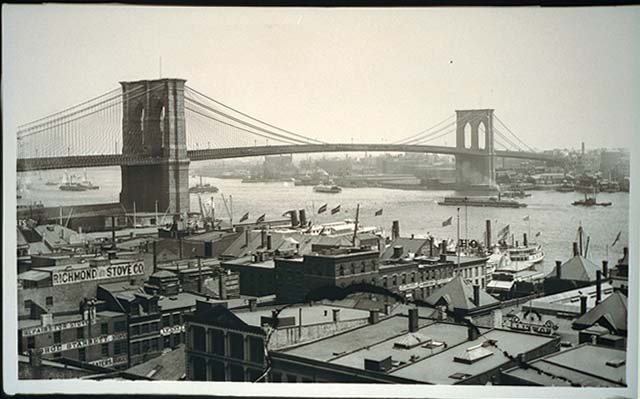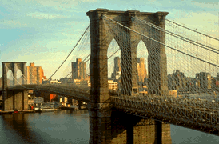


The Brooklyn Bridge, circa 1900. It is obviously
not a monument to Walt Whitman. However, as a powerful symbol, as
an icon representing an American ideal and spirit, it is relevant to the
matter at hand. A brief exploration of the bridge's history may also
be helpful in shedding light on Whitman's relevancy to bridges, and what
to make of the dedication of a Walt Whitman Bridge.
The Brooklyn Bridge was but a concept in 1800. A bridge was suggested
under a sort of Manifest Destiny spirit; a bridge across the East River,
connecting the village of Brooklyn to New York, would also thereby raise
the value of these lands on the east side of the river. At this point
in time, rural life was the inescapable norm. However, the idea of
this bridge foreshadowed a new standard; it was but a seed of the industry
and development that was on the rise. A time of urbanization, receding
rural areas, and technology was on the horizon even from this early point
in time. And it was gathering speed in its approach.
At the start of the nineteenth century, just sixty-nine years before the
construction would start on the Brooklyn Bridge, bridge building was still
in its relatively infantile stages. The biggest concern lay with
the designing of trusses, that were no longer than several hundred feet,
and were to support a moving locomotive weighing several tons (Wiedeman,
9). Suspension bridges were hardly reliable; many fell down as soon
as they were put up.
When steel was developed as a building material, the art of bridge building
took a great leap. Nevertheless, at the time that John Roebling drew
up the plans a the 3,455 foot steel suspension bridge, "nearly twice [the
length] of its nearest rival," he was taking a gamble not only on the reliability
and know-how with regard to the new material of steel, but also with the
competency of engineering.
The bridge took fourteen years to build. Construction began under
Roebling in 1869 and ended in 1883 and cost $15.5 million. The doubts
that surrounded it in the beginning, melted away upon its completion.
It was a feat, an entirely American marvel: "It should be remembered
that the Brooklyn Bridge is a 20th century bridge built by 19th century
methods. . many of the tools were the same as had been used to build
medieval Gothic cathedrals" (Weidman, 13).

When
it was complete, the Brooklyn Bridge
became a national confidence builder--
a badly
needed shot of positivism after
a civil war that
nearly ripped the country apart.
The symbol of
a bridge is not lost on anyone
who has ever
written about the Brooklyn Bridge
since.
The bridge gave 19th century Americans
a new perspective on themselves
and the world,
not unlike the perspective the
moon shot gave
us in the 20th century. For
the first time, the
average citizen could look out
over his city from
a height unattainable before.
;
(Weidman, 13)
In light of this sort of transformation, with its deep roots touching
the core of American identity, Walt Whitman has a presence. Many
of his poems express a spirit of transformation-- even going so far as
to use the metaphor of the road-- that is tied to modernization, urbanization,
the development and maturity of the country.
In Whitman's 1891-92 edition of Leaves of Grass, are these lines
from the poem "Song of the Open Road," expressing an exalted ideal of traveling
, transforming, growing, gaining new perspective. It begins with
a rural dirt road, a "brown path," and then move to the city, exalting
all along the way (Trachtenberg, 14).
Section one begins:
Afoot and light-hearted I take to
the open road,
Healthy, free, the world before
me,
The long brown path before me leading
wherever I choose.
Henceforth I ask not good-fortune,
I myself am good-fortune,
Henceforth I whimper no more, postpone
no more, need nothing,
Done with indoor complaints, libraries,
querulous criticisms,
Strong and content I travel the
open road.
Whitman professes a confidence in traveling down
this road towards change. He is about to come upon a new sort of
landscape; he crosses a bridge, in a manner of speaking. It is a
significant change in the road, and marks a critical point in the journey.
One might say it is a point of literal and figurative transformation.
Section three progresses:
You flagg'd walks of the cities!
you strong curbs at the edges!
You ferries! you planks and posts
of wharves! you timber-lined
sides! you distant
ships!
You rows of houses! you window-pierc'd
facades! you roofs!
You porches and entrances! you
copings and iron guards!
You windows whose transparent shells
might expose so much!
You doors and ascending steps!
you arches!
You gray stones of interminable
pavements! you trodden crossings!
Whitman's poetry is in step with the evolving, the transforming, the ever
shifting tide of change. This change may be viewed in personal terms,
as in personal growth; however, it may also be interpreted from the stand-point
of technology. With the exultant catalogue of early modern,
urban elements of the city, Whitman reveals an excitement, an optimism
for a wider sense of progress, similarly found with regard to the Brooklyn
Bridge.
The same points can be applied to Whitman's cultural image today.
Popularly speaking, he was more shunned than embraced for his poetry during
his time. The real value of this work, however, has unfolded
over time. Just as skeptics doubted the construction of the Brooklyn
Bridge, but later embraced it as it proved functional and awe-inspiring,
and later came to use it as a screen upon which they could project their
ideals, the same can be said of Walt Whitman.
On the other hand, all this conjecture of symbolism, of parallels, linking
the cultural roles of Whitman and the Brooklyn Bridge, or to Whitman to
bridges in general, may be bunk in light of the Walt Whitman Bridge, which
spans Gloucester, New Jersey and Philadelphia, Pennsylvania. . .

